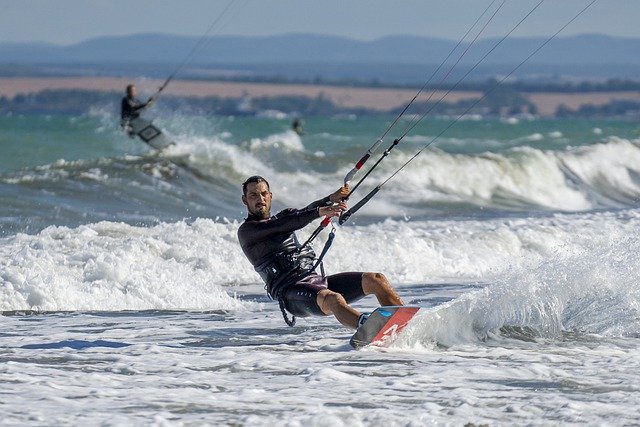Okay, so you’re committed to learning this new sport, but your wallet isn’t so sure. Okay, mine would be as well. So you are unsure of the appropriate number of lessons to schedule. You want to know the precise number of lessons you need to take before you can go on your own because most kitesurfing schools give discounts if you schedule multiple lessons at once.
Expected Time to learn
In actuality, there isn’t a clear solution. It is hard to predict a person’s rate of learning. You should leave Action Sports lessons if they guarantee you’ll be riding the board in X amount of hours. Teaching quickly is just a sales pitch; it’s not a sign of good instruction. And to make matters worse, if they set this goal and fail to meet it, the teacher is more likely to miss teaching you certain crucial lessons in order to get you riding in the allotted time.
If you don’t achieve the level in the allotted amount of time, having this expectation may also make you frustrated, make you believe you’re not very good at the sport, and even make you give up. Stay strong; you are not awful; you simply require more time, and someone has led you to feel that you must complete your study within a certain amount of time.
“There is no comparison between kitesurfing and any other sport.”
An overview of the student’s background
How do you calculate the number of hours you will require in that case? You’ll be assisted in making a decision by some signs. Are you physically fit? You play other sports, right? Has board sports ever been a hobby of yours? Any wind-related sports? If so, you’re more likely to pick things up more quickly. The learning process is slowed down by aging, it is important to remember. Sadly, as you become older—yes, we have students who are in their 70s—your brain records muscle memory far more slowly, so if you are in your 50s or older, anticipate needing more classes, regardless of how physically strong and active you are.
No other sport can be compared to kitesurfing. How often do we hear statements like, “I am a surfer/windsurfer/wakeboarder, so I will pick it up quickly. I only need two hours of lessons. That’s fantastic—you probably won’t need as many lessons as someone who doesn’t participate in those sports. However, you still need to learn how to fly a kite, recover a board, do a self-rescue, and all the other abilities unique to kitesurfing, which will definitely take more than a few hours. It might also be a disadvantage because you might have developed routines from your prior activities that don’t translate to kitesurfing, and changing those habits may be more difficult than if you were starting from scratch.
A minimum amount of time for learning
You must devote a certain amount of time to understanding the fundamentals. 6 hours of instruction is the bare minimum. To complete all of the basic workouts, it usually takes 6 hours. Some people can study them in 4 hours or less and can ace the test with little explanation, but that is the exception. Don’t be hard on yourself if it takes longer than 6 hours if you need to repeat the exercises; this is extremely frequent.
Kitesurfing lessons aren’t really for learning how to kitesurf. They’re for learning how to remain safe. A second priority is learning to ride.”
The ability to be independent
On average, pupils can become independent after 6 hours, but they won’t be able to ride regularly. What does that imply? It implies that you are no longer required to be under the supervision of a teacher and can go practice on your own. You can pick a safe place to kitesurf, evaluate the weather, find your board, launch and land the kite safely, and escape problems if it arises.
In order to cope with other kitesurfers, you also need to have strong kite control, an understanding of your equipment, behave safely on the beach, and be aware of the right of way laws. Technically speaking, you are not taking classes to learn to kitesurf; rather, you are taking lessons to improve your awareness of others’ safety. Riding instruction comes in second.
So even though you might struggle to stand up on the board, ride, or go upwind when you are “independent,” it is safe for you to practise these skills alone. Next, switching between lessons and self-practice is the ideal course of action. You can invite a kitesurfing buddy to join you if you don’t feel confident enough to go alone or sign up for further lessons if you aren’t ready to go alone. It is acceptable to request additional assistance.
“Muscle memory is built through repetition”
Time for practice
When you reach the “independent” level, do you still require lessons? If I advise a pupil to practice independently, it is because I am confident they won’t injure anyone or themselves. Making sure a kid is secure after their sessions is a major duty for a teacher.
From there, you can learn to bike and travel upwind on your own if money is scarce. However, having a teacher monitor you and provide you with honest criticism and guidance will help you understand what you are doing incorrectly and how to improve. Sometimes, just one additional lesson may make a world of difference. Due to your lack of knowledge regarding what to do and how to advance, it is extremely simple to plateau at this point. Without assistance, it may be a frustrating stage.
If you don’t want to pay a teacher every time you go kiteboarding, you’ll need to gain the self-assurance to go alone. By “alone,” I don’t mean that you have to be the only person in the water; rather, I mean without the assistance of an instructor. Kiting with other kitesurfers is always safer. Before attempting a water start on your own, you can build up your confidence with a basic body drag. If you can practise it, you’ll be prepared to work on the next thing and your class time will be more productive because repetition helps to create muscle memory.
Finally, how many lessons are required to learn how to kiteboard? Although it is advised to allow at least 6 hours, relatively few people can ride big distances reliably and comfortably in this amount of time. It can take anywhere from 6 hours to 100 hours to become independent. To make the most of your lesson time after reaching the autonomous point, it is advisable to practise independently before returning for additional instruction. It doesn’t matter how long it takes you to learn; what matters is that you do it correctly and have fun while you’re doing it. Your commitment and resolve are the only limits; it takes time and work. You can learn to kitesurf as long as you want to!
Related Posts












